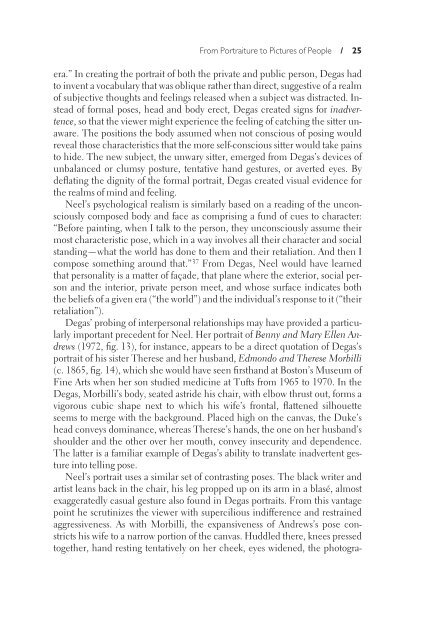i-xxii Front matter.qxd - Brandeis Institutional Repository
i-xxii Front matter.qxd - Brandeis Institutional Repository
i-xxii Front matter.qxd - Brandeis Institutional Repository
Create successful ePaper yourself
Turn your PDF publications into a flip-book with our unique Google optimized e-Paper software.
From Portraiture to Pictures of People / 25era.” In creating the portrait of both the private and public person, Degas hadto invent a vocabulary that was oblique rather than direct, suggestive of a realmof subjective thoughts and feelings released when a subject was distracted. Insteadof formal poses, head and body erect, Degas created signs for inadvertence,so that the viewer might experience the feeling of catching the sitter unaware.The positions the body assumed when not conscious of posing wouldreveal those characteristics that the more self-conscious sitter would take painsto hide. The new subject, the unwary sitter, emerged from Degas’s devices ofunbalanced or clumsy posture, tentative hand gestures, or averted eyes. Byde„ating the dignity of the formal portrait, Degas created visual evidence forthe realms of mind and feeling.Neel’s psychological realism is similarly based on a reading of the unconsciouslycomposed body and face as comprising a fund of cues to character:“Before painting, when I talk to the person, they unconsciously assume theirmost characteristic pose, which in a way involves all their character and socialstanding—what the world has done to them and their retaliation. And then Icompose something around that.” 37 From Degas, Neel would have learnedthat personality is a <strong>matter</strong> of façade, that plane where the exterior, social personand the interior, private person meet, and whose surface indicates boththe beliefs of a given era (“the world”) and the individual’s response to it (“theirretaliation”).Degas’ probing of interpersonal relationships may have provided a particularlyimportant precedent for Neel. Her portrait of Benny and Mary Ellen Andrews(1972, ƒg. 13), for instance, appears to be a direct quotation of Degas’sportrait of his sister Therese and her husband, Edmondo and Therese Morbilli(c. 1865, ƒg. 14), which she would have seen ƒrsthand at Boston’s Museum ofFine Arts when her son studied medicine at Tufts from 1965 to 1970. In theDegas, Morbilli’s body, seated astride his chair, with elbow thrust out, forms avigorous cubic shape next to which his wife’s frontal, „attened silhouetteseems to merge with the background. Placed high on the canvas, the Duke’shead conveys dominance, whereas Therese’s hands, the one on her husband’sshoulder and the other over her mouth, convey insecurity and dependence.The latter is a familiar example of Degas’s ability to translate inadvertent gestureinto telling pose.Neel’s portrait uses a similar set of contrasting poses. The black writer andartist leans back in the chair, his leg propped up on its arm in a blasé, almostexaggeratedly casual gesture also found in Degas portraits. From this vantagepoint he scrutinizes the viewer with supercilious indifference and restrainedaggressiveness. As with Morbilli, the expansiveness of Andrews’s pose constrictshis wife to a narrow portion of the canvas. Huddled there, knees pressedtogether, hand resting tentatively on her cheek, eyes widened, the photogra-
















